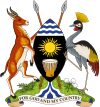 | |
| Headquarters | Kampala, Uganda |
|---|---|
| Established | August 16, 1966; 58 years ago (1966-08-16) |
| Ownership | 100 percent state ownership |
| Governor | Michael Atingi-Ego (acting) |
| Central bank of | Uganda |
| Currency | Ugandan shilling (USh) UGX (ISO 4217) |
| Reserves | US$3.919.8 billion (USh 13,838 trillion) (June 2020) |
| Preceded by | East African Currency Board |
| Website | Official site |
The Bank of Uganda (Swahili: Benki Kuu ya Uganda) is the central bank of Uganda. Established in 1966, by Act of Parliament, the bank is wholly owned by the government but is not a government department.
History
In 1979 and again in 1987, the Bank of Uganda managed to maintain an exchange rate of USh 7/= to US$1. Starting in 1987, the IMF backed the development of the Bank of Uganda, and completed its first stage of recapitalizing the central bank in 1997.
At the AFI Global Policy Forum held in Riviera Maya in Mexico in 2011, the Bank of Uganda was one of the original 17 regulatory institutions to make specific national commitments to financial inclusion under The Maya Declaration.
In June 2019, 7 directors of the bank were fired after accusations of printing their own money bills.
Organization
The board of directors of the Bank of Uganda is the bank's supreme policy making body. It is chaired by the governor or, in his or her absence, by the deputy governor.
The duties and powers of the board are specified by the Bank of Uganda Act. This Act makes the board responsible for the general management of the affairs of the bank. The board formulates policy and ensures that anything required to be done by the bank under the statute as well as anything else that is within or incidental to the functioning of the bank is carried out.
The president of Uganda appoints both the governor and the deputy governor, on the advice of the cabinet, for five-year renewable terms. Other members of the board (not fewer than four and not more than six) are appointed by the minister of finance for three-year renewable terms. The secretary to the treasury is an ex-officio member of the board.
As of June 2019, the bank employed 1,066 people. The bank of Uganda is a member of the Alliance for Financial Inclusion.
The Governor of the Bank of Uganda between 2001 and 2022 was Emmanuel Tumusiime-Mutebile (1949–2022).
Currency centres
The central bank maintains branches and currency centres in various locations around the country, whose purpose is to store, process and monitor the supply of currency to the government and private financial institutions in the surrounding cities, towns, and villages.
- Arua Branch - Arua
- Fort Portal Branch - Fort Portal
- Gulu Branch - Gulu
- Jinja Branch - Jinja
- Kabale Branch - Kabale
- Kampala Branch - Kampala
- Masaka Branch - Masaka
- Mbale Branch - Mbale
- Mbarara Branch - Mbarara
- Lira Currency Training Center - Lira
See also
- Ugandan shilling
- List of banks in Uganda
- Banking in Uganda
- Governor of the Bank of Uganda
- List of central banks of Africa
- List of central banks
References
- Weidner, Jan (2017). "The Organisation and Structure of Central Banks" (PDF). Katalog der Deutschen Nationalbibliothek.
- ^ Bank of Uganda (July 2020). "Bank of Uganda Annual Report For The Year Ending 30 June 2020" (PDF). Kampala: Bank of Uganda. Retrieved 28 September 2021.
- George Asiimwe (20 September 2022). "Government Has Never Borrowed From Us And Failed To Pay Back - Bank of Uganda". ChimpReports.com. Kampala, Uganda. Retrieved 20 September 2022.
- Richard Omongole (10 May 2020). "Bank of Uganda will kill the Ugandan economy after coronavirus". Pmdaily.com. Retrieved 5 June 2020.
- "Enhanced Structural Adjustment Facility - Policy Framework Paper, 1997/98–1999/2000" (PDF). Imf.org. 22 October 1997. Retrieved 5 June 2020.
- Alliance for Financial Inclusion (30 September 2011). "Maya Declaration Urges Financial Inclusion for World's Unbanked Populations". PR Newswire. Retrieved 20 April 2014.
- "Bank Of Uganda Directors Fired For Gross Fraud". Taarifa.rw. 28 April 2020. Archived from the original on 26 May 2021. Retrieved 5 June 2020.
- Nelson Naturinda (24 January 2022). "Bank of Uganda Governor Mutebile Dies in Nairobi". The East African. Nairobi, Kenya. Retrieved 20 September 2022.
- Bank of Uganda (29 September 2016). "Bank of Uganda Branches And Currency Training Center". Kampala: Bank of Uganda. Archived from the original on 13 March 2016. Retrieved 29 September 2016.
- Uwera, Runyambo (12 April 2010). "Central Bank Launches Currency Centre". Daily Monitor. Archived from the original on 19 April 2014. Retrieved 20 April 2014.
External links
| Uganda articles | |||||
|---|---|---|---|---|---|
| History |  | ||||
| Geography | |||||
| Politics | |||||
| Economy | |||||
| Society |
| ||||
